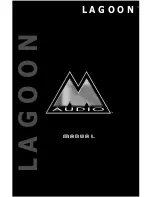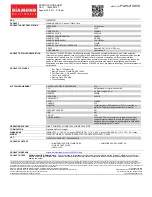
Mode
The optical input and output can be configured separately either as S/PDIF or ADAT.
This means mixing of both digital formats is possible as the LAGOON supports
mixed mode operation.
If you configure the input as ADAT, you may further activate a ‘Toshiba to Sharp’
filter by clicking on Options and then on T2S. (T2S is activated if you see a check).
The T2S is intended to compensate for differences on the optical jacks manufactured
by Toshiba and Sharp. If you have external equipment with optical jacks from
Toshiba (like the LAGOON card), you will not need the T2S. If you have equipment
that uses optical jacks from Sharp (like ADAT recorders), you should activate T2S
(even if in most cases this is not necessary). Activating T2S then helps reduce jitter.
Even if jitter does not have any influence on quality as long as you stay in the digital
domain (e.g. if you are recording to a hard disk or to an external ADAT recorder),
feeding external analog converters with an optical signal that has jitter usually
worsens audio quality.
If you do not know what kind of optical jack is used by your external equipment,
turn off T2S. Remember: T2S only achieves a slight improvement, the LAGOON
card will also work without T2S using Sharp-based devices.
Warning: Always set the correct format at the output. Choosing a
wrong format (e.g. sending an S/PDIF signal to an ADAT device)
may result in noise signals with maximum level generated at the
receiving device !
Clock Source
Whenever your intention is to synchronize your application software to an ADAT
recorder, ADAT Sync In is the choice. MIDI Machine Control, ADAT Time Code
and ADAT Word Clock coming in from the ADAT Sync cable then will give the
LAGOON card the ability of Time Code locked recording and playback. In this case,
the ADAT recorder acts as a sync master and the LAGOON as the sync slave.
For external equipment other than ADAT recorders choose Optical In as Clock
source. This is suitable when recording from CD players or DAT recorders.
If you want to have the LAGOON card acting as a clock master, choose LAGOON
as Clock source. Now you can play back to DAT recorders or to external D/A
converters. However, recording is only possible if your external device is clocked by
the LAGOON card. Otherwise recording will lead to audible distortions.
Hint: For best performance using external analog converters, they should be chosen
to be the master. If this is done, they generate the clock themselves, which is much
more precise than feeding them with an external clock. In that case the right setting
for Clock source will be Optical In.
14
Содержание Lagoon
Страница 1: ...LAGOON LAGOON MANUAL TM...














































